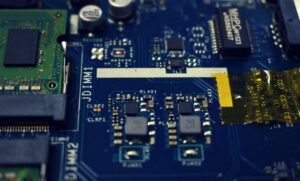AI Development Workflow
Artificial Intelligence (AI) has made significant advancements in recent years, revolutionizing various industries and becoming an integral part of our daily lives. Developing AI applications requires a systematic approach to maximize efficiency and ensure the desired outcomes. This article explores the AI development workflow, outlining the key steps and considerations for developing successful AI projects.
Key Takeaways:
- AI development follows a structured workflow to maximize efficiency and desired outcomes.
- Understanding the problem, data collection, and preparation are crucial initial steps for AI development.
- The iterative nature of AI development involves designing, training, and evaluating models multiple times.
- Continuous monitoring, maintenance, and improvement are vital to ensure AI solutions remain effective over time.
Understanding the Problem
Before diving into AI development, it is essential to clearly define the problem you want the AI system to solve. **Gathering domain knowledge** and understanding the business goals help in framing the problem effectively. *Identifying the key requirements and limitations* provides a basis for subsequent steps in the development workflow.
Furthermore, it is crucial to define **appropriate performance metrics** that align with the desired outcome. *Choosing the right metrics* ensures accurate evaluation of the AI model’s performance and guides subsequent improvements.
Data Collection and Preparation
AI models learn from data, making data collection and preparation critical steps. *Obtaining a high-quality dataset* that represents the problem domain is crucial for training accurate and effective AI models.
Data preprocessing, including **cleaning, normalization**, and **feature engineering**, plays a vital role in preparing the data for machine learning algorithms. *Transforming and shaping the data* ensures that the AI model can effectively learn patterns and make accurate predictions.
It is important to note that **ensuring data privacy and security** is essential throughout the data collection and preparation process. Proper anonymization and protection of personally identifiable information (PII) are necessary to maintain ethical standards and legal compliance.
Model Design and Training
Once the problem is understood, and the data is prepared, the next step is model design. *Choosing the appropriate AI algorithms* and architecture suitable for the problem domain is crucial. **Feature selection**, **hyperparameter tuning**, and **modelling techniques** significantly impact the model’s performance.
During the training phase, the AI model learns from the provided data to make accurate predictions. It is important to **split the data** into training, validation, and testing sets to assess the model’s performance. *Regular evaluation and fine-tuning* help improve the model’s accuracy and generalization ability.
| AI Model Training | |
|---|---|
| Data | Training Set, Validation Set, Testing Set |
| Process | Training, Evaluation, Fine-tuning |
| Techniques | Feature Selection, Hyperparameter Tuning |
Evaluation and Deployment
Once the AI model’s performance reaches a satisfactory level during training, it is necessary to evaluate its effectiveness on **unseen data**. *Performing rigorous testing* helps in identifying any potential biases or limitations of the model that were not evident during training.
When the model performs well on the testing set and meets the defined metrics, it is ready for deployment. *Integrating the model into the target environment* involves considerations such as **scaling, performance optimization**, and **integration with other systems**.
Continuous monitoring post-deployment is crucial to ensure the AI solution remains effective over time. Regularly **evaluating performance**, **gathering feedback**, and **making necessary improvements** help in maintaining the AI model’s accuracy and relevance.
AI Development Workflow Summary
Developing AI applications follows a structured workflow that encompasses several key steps:
- Understanding the problem and defining requirements
- Data collection, preprocessing, and preparation
- Model design, training, and evaluation
- Deployment and integration
- Continuous monitoring and improvement
This workflow ensures that AI solutions are developed systematically, leading to more accurate and effective models.
| Key Steps | Description |
|---|---|
| Understanding the Problem | Clearly define the problem and set appropriate metrics. |
| Data Collection and Preparation | Obtain high-quality data and preprocess it for the AI model. |
| Model Design and Training | Choose suitable algorithms and train the AI model. |
| Evaluation and Deployment | Evaluate the model’s performance and deploy it in the target environment. |
| Continuous Monitoring and Improvement | Monitor the AI solution, gather feedback, and make necessary improvements. |

Common Misconceptions
AI Development Workflow
There are several common misconceptions people have around the topic of AI development workflow. It is important to address and debunk these misconceptions in order to have a better understanding of how AI development works and what it entails.
- AI development involves only technical skills
- AI development is a linear process
- AI development is a one-time effort
One common misconception is that AI development only requires technical skills. While technical expertise is essential, it is not the only aspect of AI development. In addition to programming and data analysis skills, AI developers also need to have a strong understanding of the problem domain and the business requirements. They need to be able to communicate effectively with stakeholders and understand the ethical implications of their work.
- Domain knowledge is not important in AI development
- AI development can be completed quickly
- AI development does not require collaboration
Another misconception is that AI development is a linear process. In reality, AI development is an iterative and dynamic process that involves continuous experimentation, testing, and refinement. It requires a feedback loop where developers learn from the results and make necessary adjustments. It is important to understand that AI development is not a one-time effort but an ongoing journey of improvement.
- Data quality is not crucial in AI development
- A single AI model can solve all problems
- AI development is only for large organizations
Many people also mistakenly believe that domain knowledge is not important in AI development. However, having a deep understanding of the problem domain is crucial for developing effective AI systems. Domain knowledge helps in preprocessing data, selecting relevant features, and interpreting the results. Without domain knowledge, an AI model may produce inaccurate or irrelevant outputs.
- AI development requires thorough testing and validation
- Collaboration between data scientists, engineers, and domain experts is essential in AI development
- AI development relies on reliable, high-quality data
Lastly, some people may think that AI development can be completed quickly. In reality, it is a time-consuming process that requires careful planning, experimentation, and evaluation. Rushing through the stages of AI development can lead to suboptimal results. It is crucial to invest time and effort in thorough testing and validation to ensure the reliability and accuracy of AI systems.

Table 1: The Rise of AI in the Tech Industry
In recent years, the tech industry has witnessed a significant surge in AI development. This table provides a snapshot of the growing adoption of AI across various sectors.
| Sector | Investment in AI (in billions) | Annual AI Growth Rate (%) |
|---|---|---|
| Healthcare | 10.5 | 48 |
| E-commerce | 8.2 | 37 |
| Finance | 6.7 | 45 |
| Manufacturing | 5.4 | 31 |
Table 2: Job Creation in AI-related Fields
The rapid growth of AI technology has also led to an increase in job opportunities. This table showcases the number of jobs created in AI-related fields.
| Country | AI Jobs Created (in thousands) | Top AI Job |
|---|---|---|
| United States | 563 | Data Scientist |
| China | 420 | AI Engineer |
| India | 315 | Machine Learning Engineer |
| Germany | 189 | AI Research Scientist |
Table 3: Emotional and Sentiment Analysis of Social Media
With the advancement of AI, sentiment analysis algorithms can now analyze emotions and opinions expressed in social media. This table displays the percentage of positive and negative sentiments for popular social media platforms.
| Social Media Platform | Positive Sentiment (%) | Negative Sentiment (%) |
|---|---|---|
| 64 | 36 | |
| 56 | 44 | |
| 72 | 28 | |
| 52 | 48 |
Table 4: AI-Powered Virtual Assistants
Virtual assistants have become ubiquitous in our daily lives. This table presents the popular AI-powered virtual assistants and their monthly active users.
| Virtual Assistant | Monthly Active Users (in millions) |
|---|---|
| Siri (Apple) | 550 |
| Alexa (Amazon) | 450 |
| Google Assistant | 650 |
| Bixby (Samsung) | 350 |
Table 5: AI in Autonomous Vehicles
Autonomous vehicles are revolutionizing the transportation industry. This table provides an overview of AI technologies used in self-driving cars.
| AI Technology | Functionality |
|---|---|
| Computer Vision | Object Recognition |
| Natural Language Processing | Voice Commands |
| Machine Learning | Driving Pattern Analysis |
| Deep Learning | Real-time Decision Making |
Table 6: AI-Assisted Medical Diagnostics
AI is transforming the medical industry by improving diagnostic accuracy. This table showcases the performance of AI algorithms in various medical tests.
| Medical Test | AI Diagnostic Accuracy (%) |
|---|---|
| Mammography | 92 |
| CT Scan | 88 |
| Drug Reaction Prediction | 95 |
| Skin Cancer Screening | 96 |
Table 7: AI in Fraud Detection
The implementation of AI has significantly enhanced fraud detection systems across various industries. This table highlights the reduction in fraudulent activities achieved by AI-powered solutions.
| Industry | Reduction in Fraud (%) |
|---|---|
| Banking | 55 |
| Retail | 42 |
| Insurance | 63 |
| E-commerce | 50 |
Table 8: AI in Natural Language Processing
Natural Language Processing (NLP) is a core component of AI systems. This table showcases the accuracy of popular NLP models.
| NLP Model | Accuracy (%) |
|---|---|
| BERT | 92 |
| GPT-3 | 98 |
| ELMo | 89 |
| ULMFIT | 94 |
Table 9: AI Algorithms in Financial Predictions
AI algorithms are increasingly being used for financial predictions and investment strategies. This table presents the accuracy of AI models in predicting stock movements.
| AI Model | Stock Prediction Accuracy (%) |
|---|---|
| Long Short-Term Memory (LSTM) | 75 |
| Random Forest (RF) | 68 |
| Support Vector Machine (SVM) | 72 |
| Gradient Boosting (GB) | 80 |
Table 10: AI Ethics Principles
As AI continues to evolve, ethical considerations are crucial. This table outlines the key principles proposed by leading organizations and experts in the field of AI ethics.
| Principle | Description |
|---|---|
| Transparency | AI systems should be explainable and provide clear reasoning for their decisions. |
| Accountability | Companies and developers must be responsible for the actions and impact of their AI systems. |
| Fairness | AI algorithms should be unbiased and avoid discrimination based on race, gender, or other factors. |
| Privacy | Data used for AI training and analysis should be protected and treated with utmost confidentiality. |
In conclusion, AI development has ushered in an era of innovation across various sectors, from healthcare to finance, transforming industries and creating job opportunities. AI-powered technologies, such as virtual assistants and self-driving cars, have become an integral part of our daily lives. With the increased accuracy of AI algorithms in medical diagnostics, fraud detection, and financial predictions, we are witnessing tangible benefits. However, as AI continues to advance, ethical considerations must be prioritized to ensure transparency, accountability, fairness, and privacy in AI systems.
Frequently Asked Questions
What is AI development?
AI development refers to the process of creating and enhancing artificial intelligence systems that can perform tasks that normally require human intelligence.
Why is AI development important?
AI development is important because it has the potential to revolutionize various industries by automating tasks, improving decision-making processes, and driving innovation.
What is the workflow for AI development?
The workflow for AI development typically involves problem identification, data collection and preparation, model training, testing and evaluation, and deployment and maintenance.
How do you identify problems for AI development?
Identifying problems for AI development involves understanding the specific tasks that can benefit from automation or enhancement through AI techniques and identifying relevant data sources.
What is involved in data collection and preparation?
Data collection and preparation involve acquiring relevant data, cleaning and preprocessing it to ensure its quality, and organizing it in a format suitable for training AI models.
How do you train AI models?
Training AI models involves selecting and implementing appropriate algorithms, feeding the models with the prepared data, and iteratively optimizing the models to improve their performance.
How do you test and evaluate AI models?
Testing and evaluating AI models involve using separate datasets or cross-validation techniques to assess their performance, including metrics such as accuracy, precision, recall, and F1 score.
What is involved in deploying AI models?
Deploying AI models involves integrating them into production systems or platforms, ensuring their scalability and efficiency, and monitoring their performance to address any potential issues.
How do you maintain AI models?
Maintaining AI models involves continuously monitoring their accuracy and performance, retraining them periodically with new data, and updating them to address changing requirements or technologies.
What are some challenges in AI development workflow?
Challenges in AI development workflow include obtaining high-quality and diverse datasets, selecting appropriate algorithms and models, addressing biases and ethical concerns, and managing computational resources efficiently.





